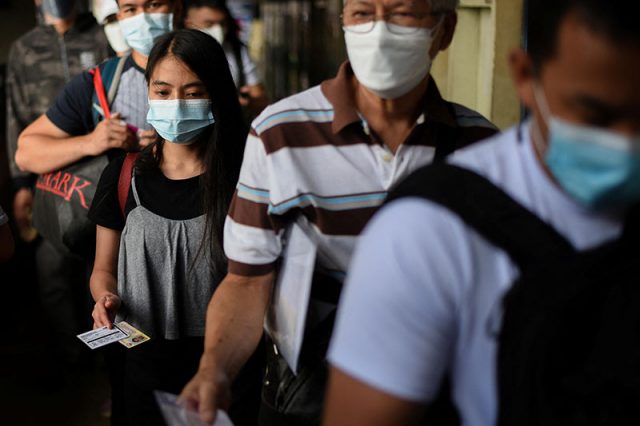
The decision to downgrade the metro’s COVID-19 Alert Level was questioned online as the country continues to battle the highly contagious Omicron variant.
Malacañang over the weekend announced that Metro Manila and some areas in Luzon, Visayas and Mindanao, would be placed under Alert Level 2 from February 1 to 15.
These include Batanes, Bulacan, Cavite, Rizal, Biliran, Southern Leyte and Basilan.
Under Alert Level 2, establishments are allowed to operate indoors at 50% of venue capacity and 70% seating capacity for activities conducted outdoors.
Other areas are under the stricter Alert Level 3.
Alert Level 2 was the same restriction imposed during the 2021 holidays, just weeks before the country’s Omicron surge in January.
This alert level is implemented in areas where COVID-19 case transmission is low and decreasing, healthcare utilization is low, or cases are low but increasing, or cases are low and decreasing but bed utilization and ICU utilization is increasing.
The National Capital Region has been under Alert Level 3 since January 3 after the health department detected local cases of the Omicron variant.
The NCR’s ease to Alert Level 2 raised concerns among Filipinos who found the decision of the national government “hasty.”
“GG nagbababa ng alert levels ‘pag may holiday (CNY and Valentine’s). 35+% positivity rate not concerning?” a Twitter user commented, pertaining to Chinese New Year which is on February 1.
“Nagmamadali na naman silang mag-baba ng Alert Level Status (facepalm emoji). Tapos niluwagan pa ang quarantine protocols para sa mga manggagaling ng ibang bansa… good luck sa pagpapababa ng mga kaso,” another online user said.
The national government recently suspended its COVID-19 risk classifications for countries and territories.
READ: Philippines to reopen in February to vaccinated foreign tourists
Fully-vaccinated travelers from visa-free countries must present a negative RT-PCR test taken within 48 hours prior to departure from the country of origin starting February 10.
They won’t be required to observe a facility-based quarantine as well.
Instead, they will have to self-monitor themselves for any signs or symptoms for seven days, with the first day being the date of arrival, and then report to their local government unit upon the manifestation of symptoms, if any.
Another Twitter user who identified himself as a pediatric resident took note of the positivity rate and alleged that some hospitals are still full amid the planned de-escalation.
“LEVEL 2 AGAD??? Above 30% pa positivity rate natin (and puno pa hospitals). Tapos Level 2? Sige, gawin natin 40-50% positivity rate. Ito problem ng government natin, ang bagal ng response, ang bilis maging kampante,” he wrote.
As of January 31, the positivity rate is at 28.4%. ABS-CBN data analyst Edson Guido said it is the “lowest since January 2.”
“Positivity rate” refers to the percentage of tests conducted that came out positive for COVID-19. A positivity rate of 50% means that one in every two tests will come out positive for the virus.
The World Health Organization says that for an infection to be declared controlled, this must only be at five percent.
Meanwhile, some experts also echoed some online Filipinos’ sentiments about NCR’s downgrade to Alert Level 2 and suggested that the government should take it slow.
The University of the Philippines Pandemic Response Team urged the government to delay the downgrade by a week to ensure “proper implementation of protocols.”
“What we’re suggesting is dahan-dahan because… we still don’t have any research how the natural immunity from Omicron can protect us and (the) second one, even though there’s already a declining phase in terms of transmission in NCR, the number is still in thousands,” UP professor Jomar Rabajante said in an interview.
“What we suggest is for protocols to be really implemented, unlike in December,” he added.
The team said that cities in Metro Manila need to have at least an average daily attack rate of less than 75% for the restrictions to be loosened.
OCTA Research fellow Guido David also said that the government could have extended NCR’s Alert Level 3 for one to two more weeks instead.
“Personally, I might have taken a slightly more cautious approach and maybe waited one week or two weeks. One to two weeks in the scheme of things will not be a long wait if we waited one to two weeks,” he said in a forum.
Health Secretary Francisco Duque III previously said that the metro has seen a decline in COVID-19 cases. The vaccination rate, on the other hand, is high.
He also said that the alert level classification depends on the area’s two-week growth rate, average daily attack rate (ADAR) and health care utilization rate.
Acting Palace Spokesperson Karlo Nograles explained this in a press briefing on Monday.
“Pagdating sa NCR, ‘yung ating total bed utilization ay nasa below 49%. Ganun din sa Bulacan, sa Rizal, sa Cavite, sa Biliran, Southern Leyte, at sa Basilan. Dahil nasa 0% to 49%, which is our lowest classification for total bed utilization, nasa low risk na po siya,” he said.
“Kung titignan niyo po ‘yung ADAR pati ‘yung two-week growth rate po ng nabanggit ko ng areas… nasa moderate risk po sila. Dahil po doon, pwede po siyang ma-deescalate to Alert Level 2. Ayun po ‘yung nakita ng IATF [Inter-Agency Task Force], ayun din po yung pinresente ng sub-technical working group, at base na rin sa mga advise ng mga health experts,” Nograles added.
Two weeks ago, the OCTA Research Group said that the NCR’s positivity rate may be decreasing as an effect of testing limitations.
This means the metro’s capacity for testing might have already reached its limit, resulting in a supposed artificial decrease in numbers.
The health department previously revised its COVID-19 testing protocols and said that asymptomatic close contacts who are not part of vulnerable groups are no longer required to get tested.
READ: Asymptomatic individuals still infectious, DOH told, as it moves focus away from testing, tracing
Meanwhile, Nograles reminded the public to continue to observe the minimum health protocols which include the wearing of face masks, practicing physical distancing and the washing of hands.
He also urged them to get vaccinated as soon as possible to prevent the risk of getting hospitalized due to COVID-19.









